Wheat is one of the main grain crops in Russia. The raw materials obtained from it are used for baking bakery products, making cereals, pasta, alcohol. Technologically, growing wheat is a rather complicated procedure. However, careful observance of all cultivation conditions makes it possible to obtain very good harvests of it, including in Russia.
The main growing regions in the Russian Federation
One of the advantages of wheat is its relative undemanding to weather factors. Therefore, this crop is cultivated in many regions of our country. Indisputable leaders in this regard are such wheat growing areas as the Stavropol and Krasnodar Territories. They account for a total of about 22% of the total threshing in the country.

In second place in wheat harvests are Volgograd, Saratov, Omsk, Kursk, Voronezh regions and Altai. The share of each of these regions is about 3-4%. In Siberia and the Urals, about 2-3% of grain is harvested. Growing wheat is also one of the specializations of farmers in the Belgorod, Penza region and some other regions.
What other countries are cultivating
This popular culture is grown in many countries of the world. China produces the most wheat - 126.21 million tons of grain per year. Russia is in third place after India in the list of countries cultivating this crop. About 60 million tons of grain are produced annually in our country. India produces 95 million tons per year. The United States is behind Russia on the list. Farmers of this country collect 55.4 million tons annually. Ukraine is on the tenth place in the list of wheat producing countries. About 24.11 million tons per year are threshed in this state.
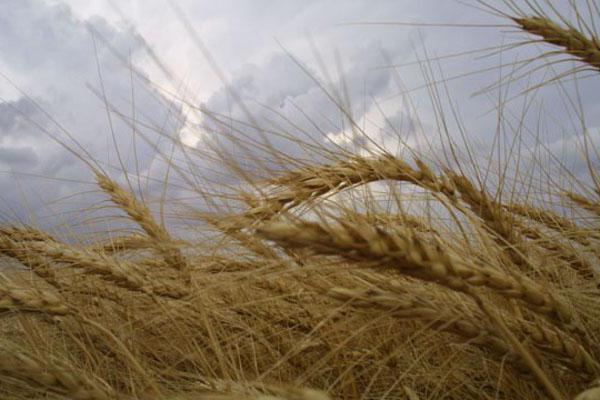
Wheat growing conditions
The crop of wheat is quite unpretentious. However, she still prefers a continental climate, quite warm. According to the growing conditions, steppes are best suited for wheat. Indeed, the area under this crop is usually very large for good yields. What specific optimal environmental conditions are needed for wheat can be found in the table below.
Parameter | Value |
Air temperature for seed germination | 1-2 s |
For the appearance of seedlings on the surface | 3-4 s |
Sum of temperatures from emergence to heading | 800-900 C |
Minimum allowable temperature (short-term) | -10 C |
Germination moisture | 50-60% water by weight of dry grain |
Soil moisture | 70-75% of the lowest moisture capacity |
It is these agroclimatic conditions that are favorable for growing wheat. Too high temperatures, this culture does not tolerate well enough. Therefore, in a hot sharply continental climate, large yields cannot be obtained. At 38-40 C in most varieties stomata begin to die.
Light mode
Of course, it is not only the agroclimatic conditions of wheat cultivation, such as soil moisture and air temperature, that influence crop yields. A very important factor in this regard is the duration of daylight hours. A large wheat crop can be obtained, unfortunately, only with a fairly significant number of sunny days during the season. The lack of light contributes to the formation of a large number of internodes in this culture. At the same time, the tillering leaf of wheat grows too close to the soil surface. All these factors negatively affect the endurance of plants, their resistance to pests, diseases and low temperatures.
Which soil is best suited
The main conditions for growing wheat successfully is a fairly high air temperature and humidity in the summer. In terms of climate, this culture is therefore not too demanding. However, sites for its landing have to be selected very carefully. In terms of soil composition, this crop, in comparison with many other crops, is relatively moody. It is believed that wheat feels best on loamy soils (sod-podzolic) and loamy sand. Good yields of this crop can also be obtained on peat-bog lowland soils.
The optimal soil indicators for wheat are:
pH - minimum 5.8;
humus content - at least 1.8;
K2O and P2O5 - a minimum of 150 mg / kg of soil.
The best predecessors
Repeated crops of wheat in the fields, unfortunately, lead to a significant decrease in productivity due to depletion of the soil and morbidity. Therefore, when growing this crop, you must follow the rules of crop rotation. Legumes and potatoes are thought to be the best precursors for wheat. You can also plant it after cruciferous vegetables or herbs.
Types of wheat
On the fields of Russia are grown a variety of types of this culture. Wheat can be classified into varieties:
hard and soft;
simple and dwarf.
From hard grains, flour is obtained, which is mainly used for making noodles and pasta. Such wheat is distinguished by a dense spike structure and the presence of long awns. The cavity of the straw in varieties of this group is filled with connective tissue. The hard grain itself has an elongated shape.
Soft wheat is most often grown in the fields of our country and other countries. Grain of precisely such varieties is used for baking bread. Also, flour of this variety is great for the manufacture of confectionery. For soft varieties of wheat, a rather loose spike is characteristic. She has no awns. The straw in this variety is hollow, and the grain has a round shape.
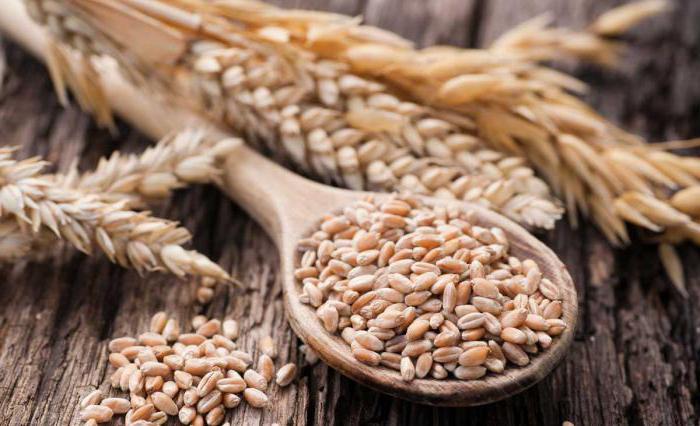
Dwarf varieties have been recently bred and farmers are far enough rare farmers to grow. It is believed that the flour obtained from such grain is very suitable for baking.
Spring and winter wheat
Wheat cultivation in our country can be carried out using two main technologies. Winter varieties are planted in autumn. Harvest them next summer. Spring wheat is sown in the spring. Its ears ripen by autumn.
Varieties
The conditions for growing wheat in Russia in most cases are favorable. This culture is cultivated, as already mentioned, in many regions of our country. Zoned varieties of it are also used just a huge amount. The most popular and productive ones include the following spring:
"Dawn". This mid-ripening wheat is the standard in the state trials.
Munch. This is a German mid-season high grade, resistant to lodging.
"Tom." New cultivar resistant to powdery mildew.
Coke. Resistant to disease and lodging variety.
And winter:
"Prestige";
Moskovskaya-39;
"Lelya";
Mironovskaya, etc.
Spring wheat sowing
Varieties of this variety are grown mainly in the Urals, in the Volga region and in Siberia. The technology of tillage for such wheat depends on the composition of the latter, as well as on its predecessors. Usually this procedure includes:
in fields with stubble predecessors - peeling of cherries with disk implements;
after row crops, cultivation to the depth of the arable layer.
Pre-sowing preparation on peatlands includes disking, leveling the soil and rolling.
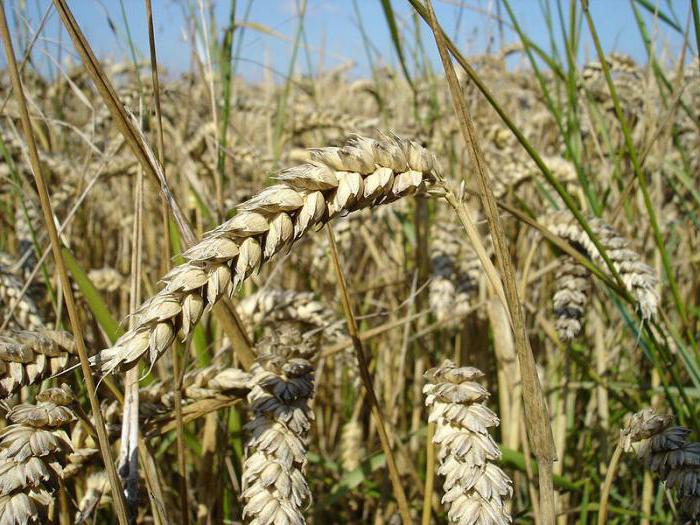
Seed preparation
Growing spring wheat will be successful, of course, only if you use high-quality planting material. Grain for sowing fields in spring is allowed to use only III reproductions with a purity of 98% and a germination rate of 87%. Pre-seeds are treated using special preparations.This allows you to reduce the incidence of crops during the cultivation process. Sometimes spring wheat seeds are pickled and inlaid. In this case, the composition of the preparation used for processing includes adhesives and growth-regulating compounds. Also, when preparing seeds, humic agents can be used.
How to sow
Spring wheat is a culture of early planting. Sow it at a soil temperature of 2 ° C. On peat soils, such varieties are planted after thawing the top layer by 10-12 cm. The sowing rate of spring wheat seeds is approximately 5-5.5 million on mineral soils and 3.5-4 million on peat soils.
Grains of this culture are planted to a depth of 5-6 cm on light soils and 3-4 cm on heavy soils. Spring wheat is sown by the continuous method with a row spacing of 7.5, 12.5 or 15.0 cm.
Care
The technology for growing spring wheat includes mainly the following types of work:
harrowing for weed control (5-7 days after sowing);
the use of herbicides for weed control;
when pests appear, treatment with insecticides;
in case of infection with bacterial diseases, the use of fungicides.
How spring varieties are fertilized
The use of top dressing is one of the most important conditions for such a procedure as growing wheat in Russia. Regions with nutrient-rich chernozems are rare for our country.
Spring varieties are fed during tillering. In the early stages of development, such wheat is insensitive to mineral fertilizers. When exiting the tube, the use of nitrogen top dressings gives good results. Also during this period, wheat is in urgent need of phosphate fertilizers. During the earing of spring varieties, potash is usually used. They are also used when pouring grains.
When calculating the required amount of fertilizer, one should take into account the fact that one centner of spring wheat from the earth absorbs 1.2 kg of phosphorus, 4 kg of nitrogen, 2 kg of potassium per season.
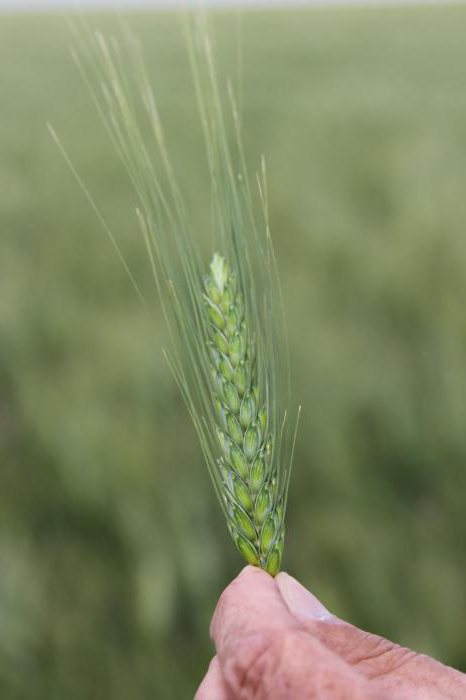
Spring wheat harvest
Direct combining of such varieties is carried out upon reaching 15-20% moisture content of the grain. You can’t be late in harvesting spring wheat. When such varieties cease, even for 10-12 days, the grain quality deteriorates significantly. In this case, the yield itself is also reduced.
Winter wheat: preparation for sowing
Thus, we found out how spring varieties are cultivated. Next, let's look at what is the technology of growing winter wheat. Varieties of this variety are most often cultivated in the Caucasus, in the Central Black Earth region and in the Volga region. Soil preparation winter wheat requires even more thorough than spring wheat. In this case, when choosing a technology, factors such as the condition of the earth and its predecessors are also taken into account. After unpaired crops in the fields under winter wheat, usually combined units are used. Actually, the processing itself is most often performed using the non-moldboard method to a depth of 8-12 cm. It is believed that the following are the best indicators of soil for such varieties:
sufficiently dense under-sowing layer;
the size of soil particles in the pre-sowing formation is 2-3 mm;
the height of the ridges after the cultivator is less than 2 cm.
Cultivators when processing fields for winter wheat are supplemented with harrows and rollers. This is necessary in order to ensure good contact of the seeds with the soil.
Planting Material Processing
The conditions most favorable for growing winter wheat are wet autumn, snowy winter, warm spring. However, good yields of such varieties can be obtained only with the same thorough preparation of seeds as the grains of spring varieties. Winter planting material is usually processed in two stages by:
dressing;
inlaid.
When pickling, it is important not to impair seed germination.
Winter wheat sowing
This field procedure can be performed using three technologies:
ordinary lowercase (row spacing - 15 cm);
narrow-row method (7.5 cm);
cross method (15 cm).
As for spring, for winter wheat the simplest line method is most often used. Close the seeds of varieties of this variety on light soils to a depth of 6-8 cm, on heavy soils - 1-2 cm, on peat - 3-4 cm.
The grain rate in this case depends on the planting time. With early sowing, the flow rate should be 400-500 pieces per 1 m2. If the landing is made in the late stages, this rate increases by 10-15%.
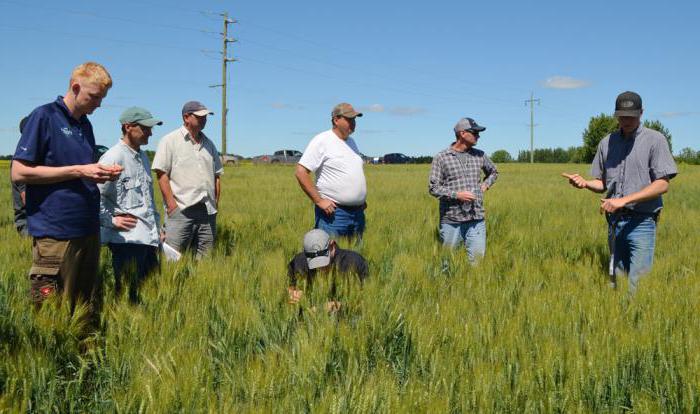
Growing winter wheat: the basics of care
When cultivating varieties of this variety, like spring crops, herbicides are often used to control weeds. Pests are killed by insecticides, and bacterial diseases are treated with fungicides if necessary. In addition, it is believed that winter wheat responds very well to fertilizers. This culture is fed mainly with mineral compounds. Organic fertilizers may only be used if the percentage of humus in the soil does not exceed 2%.
The norms of mineral fertilizing are calculated based on the composition of the land in the field. The best fertilizers for winter wheat are nitrogenous and phosphorous. Almost the entire norm of the latter is introduced before sowing. Most often, fields for winter wheat are fertilized with granular superphosphate. The same composition is introduced randomly during autumn top dressing or by the root method in early spring (in small quantities).
The cultivation of winter wheat in Russia involves the use of nitrogen fertilizers:
during pre-sowing cultivation (30 kg / ha);
in the tillering phase to increase the density of plants and the height of their stem;
at the beginning of tubulation (60-70 kg / ha);
during heading and flowering.
If winter wheat is grown on poor soil, nitrogen fertilizers are recommended in ammonium form. In this case, top dressing will be less washed out. In the steppe regions in the fields, foliar feeding of winter wheat with a urea solution is often used.
How to water
Incorrect soil moisture control can lead to a significant decrease in the yield of such varieties. Growing winter wheat bIt will be successful only if its root system is actively developed. Especially important is the indicator of soil moisture in the early stages of crop development. In autumn, due to rains, the topsoil in the fields is quite moist. From it, the nutrients of newly planted plants are extracted. The same applies to the period of snow mass descent. Melt water in spring supports wheat very well.
Subsequently, with increasing air temperature, the soil, however, begins to gradually dry up. In accordance with this, the root system of plants lengthens and expands. Wheat independently extracts moisture from deeper layers of the soil. In some cases, the root system of this culture can reach a length of almost a meter. However, in dry weather, moisture can go deeper into the soil. And at a distance of 1 m from the surface by the middle of June it is often not enough. Arid wheat cultivation areas are thus a risky area. Irrigating fields with grain in such regions is a must.
There are two periods of development of this crop, watering in which is simply necessary. First of all, it is autumn vegetation. The soil at this time of year in the fields is in most cases moist. However, it often happens that the percentage of its moisture for the normal development of plants is still not enough. In addition, rains in mid-October do not always happen. Winter varieties are watered in autumn, usually only once, but abundantly.
The second time, winter wheat crops are artificially moistened in the spring. However, this procedure is carried out only if in the fall the soil was saturated with water less than two meters in depth.
In summer, winter wheat is watered only during drought. This is usually done at the time of heading and at the beginning of grain ripening.
In the same way, spring wheat is watered in the summer.The roots of the varieties of this variety must also reach the moist layers of the soil. Otherwise, it will not be possible to get a good harvest from spring crops. With a lack of watering, it will not be possible to increase the yield of grain even when using a large number of fertilizers.
Harvest Dates
Combining of winter varieties begins in the phase of their full maturity. Different regions of wheat cultivation differ in different climatic conditions. Therefore, suffering occurs in different areas at different times. In any case, combining should be done only when the grain moisture reaches 14-17%.
Harvesting winter wheat can be performed by different methods. Most often, direct combining is used. If the crops are too heavily clogged with weeds, a separate method of harvesting is used. In this case, grain losses are usually quite large. Therefore, it is so important to treat the fields with herbicides during the growth and maturation of winter wheat. A separate harvesting method is also used for tall and very dense varieties.
Storage
The cultivation of wheat is technologically quite complicated. But getting a good crop of this crop is not enough. It is also important to keep it lossless.
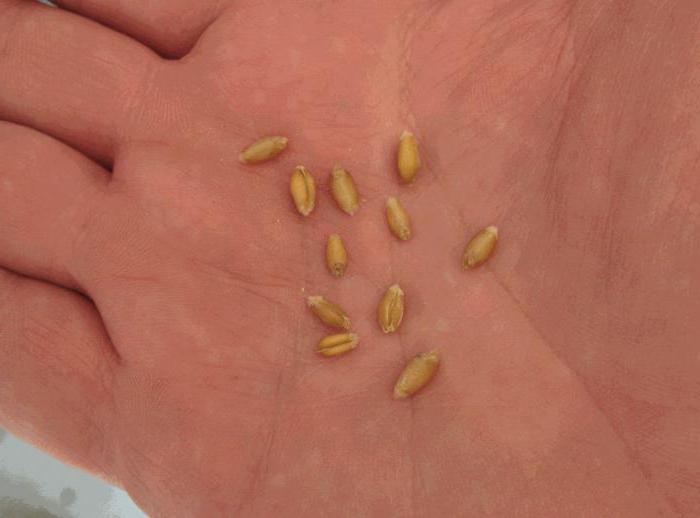
After harvesting, grain is most often sent to elevators. The following factors affect the safety of the harvest in such specially equipped warehouses:
humidity and ambient temperature;
the intensity of the biochemical processes occurring in the grain layers;
the presence or absence of harmful microorganisms and insects.
Before storing for storage, the grain must be carefully dried. The optimum storage temperature for wheat is 10-12 C. Compliance with these factors helps prevent grain damage and weight loss.